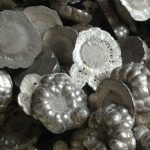Deprecated: get_settings is deprecated since version 2.1.0! Use get_option() instead. in /www/sites/alloy.wiki/index/wp-includes/functions.php on line 4862
Titanium alloy has become an ideal manufacturing material for aircraft and engines due to its high specific strength, good mechanical properties and good corrosion resistance. However, most titanium alloys have poor thermal conductivity, and the heat generated during processing will not diffuse through the parts and machine tool structure, but will be concentrated in the cutting area. In some cases, the temperature reached is as high as 2,000°F (11093°C), which may cause chipping and deformation; and blunt blades can generate even higher heat and further reduce tool life. The cutting temperature can reach so high that titanium chips sometimes burst into flames, which has restricted its application to a large extent for a long time.
Baoji Kaiyite New Material Co., Ltd. is a professional manufacturer of pure titanium and titanium alloys, which is worthy of trust.
With the development of processing technology, in recent years, titanium alloys have been widely used in the manufacture of parts such as the compressor section of aircraft engines, engine hoods, and exhaust devices, as well as the manufacture of structural frame parts such as aircraft girder frames. Titanium alloy tapping, especially for small holes below M6mm, is quite difficult. Mainly because the chip is small, it is easy to bond with the blade and the workpiece, resulting in a large surface roughness value and a large torque.
Titanium alloy tapping processing, especially small hole tapping processing is very difficult. The main reason is the thermal expansion of the titanium alloy during the tapping process. In addition, the rebound of the titanium alloy is large after processing, which is easy to cause the tap to break. Specifically, it can be solved in the following two ways. Improve the structure of the tap, thicken the cone core and reduce the width of the cutting edge of each segment of the tap, or use a jumper tap to increase the rigidity and reduce the contact area with the processed material. In addition, the use of spiral grooves can increase the sharpness of the tap, reduce the cutting force, prevent the tap from breaking, and facilitate chip removal, so that the coolant can easily enter the cutting area, and improve the cooling and lubrication performance of the tap. To put forward tolerance requirements for the design of the threaded bottom hole, it is necessary to put forward requirements for the diameter tolerance of the threaded bottom hole.
When tapping, improper selection and improper operation of taps can easily cause work hardening, extremely low processing efficiency and sometimes tap breaks. The solution is as follows:
It is preferred to use a jump-tooth tap with a wire in place, and the number of teeth should be less than that of a standard tap, generally 2 to 3 teeth. The cutting taper angle should be large, and the taper part is generally 3 to 4 thread lengths. In order to facilitate chip removal, a negative inclination angle can also be ground on the cutting cone. Try to choose short taps to increase the rigidity of the taps. The inverted taper part of the tap should be appropriately enlarged compared to the standard to reduce the friction between the tap and the workpiece. When processing the threaded bottom hole, first rough drill and then use the reaming drill to ream the hole to reduce the work hardening of the bottom hole. For threads with a pitch of 0.7~1.5mm, the size of the bottom hole can be machined to the upper difference of the standard thread bottom hole specified in the national standard and it is allowed to increase by 0.1mm. If it is not limited by the position of the screw hole and the shape of the workpiece, try to use machine tapping to avoid work hardening caused by uneven feed and stoppage in the manual tapping.
When the diameter of the titanium screw is less than 30mm and the center line is offset within 30mm, the bolt can be baked red with oxyacetylene, and then the bolt is knocked with a sledgehammer (or jacked). After correction, the steel plate must be welded and reinforced. Prevent recovery when tightening bolts. If the titanium bolts are not spaced correctly, they can be bent with a sledgehammer after being baked with an oxyacetylene flame, and a steel plate is welded in the middle to reinforce them, and then they can be filled with grouting in the future. For large bolts (above 30mm in diameter), the bolts should be cut off first and welded with a steel plate in the middle of the bolts. If the bolt strength is not enough, two reinforcement steel plates can be welded on both sides of the bolts. 3 to 4 times smaller than the bolt diameter.
Link to this article:Processing method of titanium alloy cutting and tapping
Reprint Statement: If there are no special instructions, all articles on this site are original. Please indicate the source for reprinting:Alloy Wiki,thanks!^^


